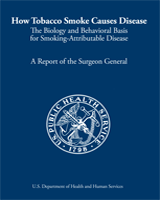NCBI Bookshelf. A service of the National Library of Medicine, National Institutes of Health.
Centers for Disease Control and Prevention (US); National Center for Chronic Disease Prevention and Health Promotion (US); Office on Smoking and Health (US). How Tobacco Smoke Causes Disease: The Biology and Behavioral Basis for Smoking-Attributable Disease: A Report of the Surgeon General. Atlanta (GA): Centers for Disease Control and Prevention (US); 2010.

How Tobacco Smoke Causes Disease: The Biology and Behavioral Basis for Smoking-Attributable Disease: A Report of the Surgeon General.
Show detailsfrom the Surgeon General, United States Public Health Service
In 1964, the Surgeon General released a landmark report on the dangers of smoking. During the intervening 45 years, 29 Surgeon General’s reports have documented the overwhelming and conclusive biologic, epidemiologic, behavioral, and pharmacologic evidence that tobacco use is deadly. Our newest report, How Tobacco Smoke Causes Disease, is a comprehensive, scientific discussion of how mainstream and secondhand smoke exposures damage the human body. Decades of research have enabled scientists to identify the specific mechanisms of smoking-related diseases and to characterize them in great detail. Those biologic processes of cigarette smoke and disease are the focus of this report.
One-third of people who have ever tried smoking become daily smokers. This report investigates how and why smokers become addicted and documents how nicotine compares with heroin and cocaine in its hold on users and its effects on the brain. The way tobacco is grown, mixed, and processed today has made cigarettes more addictive than ever before. Because of this, the majority of smokers who try to quit on their own typically require many attempts. It is imperative that we use this information to prevent initiation, make tobacco products less addictive, and provide access to treatments and services to help smokers quit successfully.
This new report also substantiates the evidence that there is no safe level of exposure to cigarette smoke. When individuals inhale cigarette smoke, either directly or secondhand, they are inhaling more than 7,000 chemicals: hundreds of these are hazardous, and at least 69 are known to cause cancer. The chemicals are rapidly absorbed by cells in the body and produce disease-causing cellular changes. This report explains those changes and identifies the mechanisms by which the major classes of the chemicals in cigarette smoke contribute to specific disease processes. In addition, the report discusses how chemicals in cigarette smoke impair the immune system and cause the kind of cellular damage that leads to cancer and other diseases. Insight is provided as to why smokers are far more likely to suffer from chronic disease than are nonsmokers.
By learning how tobacco smoke causes disease, we learn more about how chemicals harm cells, how genes may make us susceptible, and how tobacco users become addicted to nicotine. The answers to these questions will help us to more effectively prevent tobacco addiction and treat tobacco-caused disease. Understanding the complexity of genetic, biochemical, and other influences discussed in this report offers the promise of reducing the disease burden from tobacco use through earlier detection and better treatment; however, even with all of the science presented here, it currently remains true that the only proven strategies to reduce the risks of tobacco-caused disease are preventing initiation, facilitating cessation, and eliminating exposure to secondhand smoke.
My priority as Surgeon General is the health of the American people. Although we have made great strides in tobacco control, more than 440,000 deaths each year are caused by smoking and exposure to secondhand smoke. The cost to the nation is tremendous: a staggering amount is spent on medical care and lost productivity. But most importantly there is immeasurable cost in human suffering and loss.
In 1964, Surgeon General Luther Terry called for “appropriate remedial actions” to address the adverse effects of smoking. With this report, the devastating effects of smoking have been characterized in great detail and the need for appropriate remedial action is even more apparent. The harmful effects of tobacco smoke do not end with the users of tobacco. There is no safe level of exposure to tobacco smoke. Every inhalation of tobacco smoke exposes our children, our families, and our loved ones to dangerous chemicals that can damage their bodies and result in life-threatening diseases such as cancer and heart disease. And, although not a focus of this report, we know that smokeless tobacco causes cancer and has other adverse health effects. The science is now clear that “appropriate remedial actions” include protecting everyone in the country from having to breathe secondhand smoke; making all tobacco products progressively less affordable; expanding access to proven cessation treatments and services; taking actions at the federal, state, and local levels to counteract the influence of tobacco advertising, promotions, and sponsorship; and ensuring that all adults and children clearly understand that the result of tobacco use is addiction, suffering, reduced quality of life, and all too often, early death. Forty-five years after Surgeon General Terry called on this nation to act, I say, if not now, when? The health of our nation depends on it.
Regina Benjamin, M.D., M.B.A.
Surgeon General
- Preface - How Tobacco Smoke Causes Disease: The Biology and Behavioral Basis for...Preface - How Tobacco Smoke Causes Disease: The Biology and Behavioral Basis for Smoking-Attributable Disease
- Oryza sativa Japonica Group DNA, chromosome 11, cultivar: Nipponbare, complete s...Oryza sativa Japonica Group DNA, chromosome 11, cultivar: Nipponbare, complete sequencegi|937937345|dbj|AP014967.1|Nucleotide
- protein DETOXIFICATION 29, partial [Glycine max]protein DETOXIFICATION 29, partial [Glycine max]gi|2027478507|ref|XP_006586536.2|Protein
Your browsing activity is empty.
Activity recording is turned off.
See more...